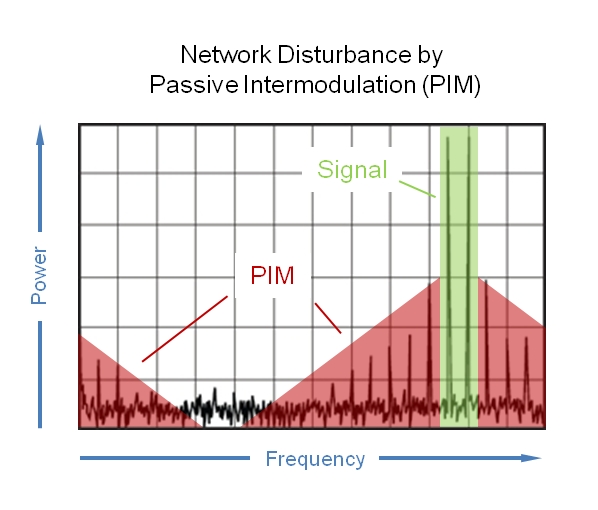Maximizing Network Capacity by Minimizing Passive Intermodulation (PIM)
Share

Modern wireless high-speed data networks use tightly grouped channels and complex modulation schemes to enable transmitting vast amounts of data. This in association with ultra-sensitive receivers may face unanticipated but serious capacity losses if the network is disturbed by Passive Intermodulation or PIM for short. Generally, modulating RF signals is necessary to transport information, but arbitrary passive intermodulation can significantly impact RF signal performance. Unfortunately, PIM can happen whenever more than one signal is channeled through one RF path. As a result, we may see unwanted non-linear frequency responses of passive components including connectors and cable feeds. These components start acting like mixers, modulators and frequency multipliers creating unwanted spurious products.
PIM (Passive Intermodulation distortion)
PIM may become a major problem when Tx and Rx signals share one RF path. Typically, VSWR measurements are standard procedure after network installation. Such measurements determine how much RF energy the antenna emits, and how much unwanted energy is reflected back into the transmitter. VSWR meters are, however, are incapable of detecting non-linearity in system components. Validating PIM network quality requires special PIM test systems. The preferred scenario for best network quality is – preventing PIM in the first place. To achieve this, it is paramount to utilize only high quality, low PIM components, apply proper installation procedures, and ensure excellent grounding of the RF system.
Why is it critical to eliminate PIM?
PIM can be generated whenever base stations transmit RF signals. The resulting intermodulation frequency products are often found within the receiving bands of a network. Since RX signals are, by nature, of very low power, interference with regular voice and data traffic occurs. Unwanted PIM interference may desensitize one or more receiving channels to such a degree that it not only creates very high BER that reduces network bandwidth, but it may even drop calls altogether. In the worst case scenario, it can even lead to permanently unusable receiver channels. Loss of already sparse network capacity caused by PIM is unacceptable for high volume, high speed wireless data networks.
What causes Passive Intermodulation?
- Ferromagnetic metals, like iron, nickel and steel, show hysteresis effects with applied energy. The resulting signal levels are altered and the signal response is no longer linear.
- Dissimilar metal plating on connectors constitutes potential voltaic elements that act like a diode, causing unwanted random modulation effects.
- Corroded surfaces cause PIM. Corrosion may happen on unprotected component surfaces or by human influence (e.g. touching a connector pin with bare fingers)
- Irregular contact surfaces, even on a microscopic scale, can cause an inconsistent flow of charge carriers and generate inhomogeneous electromagnetic fields. Causes can be of mechanical or electrical nature: low quality components, shearing by forced connections and disconnections of components, spark craters caused when “hot” connections are disconnected.
- Wind load and dissimilar expansion coefficients of tower and feed lines stress both, connectors and cables, and will cause deteriorating connection quality.
The wireless network of a large Australian operator presented serious bandwidth problems when extended with modern 3G and 4G technologies. Despite installing latest technologies, the overall network performance was not even close to the expected levels. It turned out that the network itself generated extraordinarily strong interference during signal transmissions. Culprits were inferior diplexers that generated strong PIM. Once these components were replaced with high quality, low PIM types, the network performed flawlessly.
Another operator in the US faced high rates of dropped calls in a certain market. Many sites were tested and swept by service crews but revealed to be in great condition. Basic screening, however, did not detect that the newly installed wideband antennas generated too much PIM due to a manufacturing issue. Once the problem had been pinpointed with PIM measurement equipment, action could be taken. The faulty antennas were replaced and dropped calls virtually disappeared.
Conclusion
Minimizing Passive Intermodulation (PIM) is critical for achieving maximal system capacity and efficiency of wireless high-speed networks. PIM awareness is paramount for PIM prevention. Installers need to be trained properly to ensure their familiarity with the causes of PIMs and their expertise on how to prevent it. RF and DAS equipment manufacturers must deliver products that possess low PIM characteristics, but guarantee sustained specifications over time under environmentally harsh conditions. System designers must account for PIM in their DAS designs, consider low PIM products where appropriate, and pay special attention to material and plating of mating component surfaces. Finally, wireless operators need to maintain the performance level of their network, ensuring that PIM behavior does not deteriorate the operation of the system.
- Wi-Fi Design Strategies in a Converged World Webinar Questions Part 4: Industry Related Questions - December 4, 2017
- Wi-Fi Design Strategies in a Converged World Webinar Questions Part 3: iBwave Products - October 5, 2017
- Wi-Fi Design Strategies in a Converged World Webinar: Your Questions Answered. - August 9, 2017



















